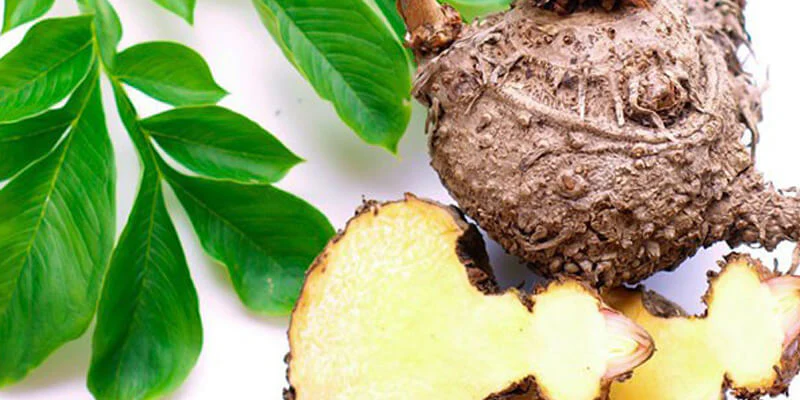
Konjac is a kind of renascent herbaceous plant, which mainly grows in the subtropical mountain or hilly areas. There are about 170 kinds of Konjac in the world and about 20 kinds of Konjac in China. The main ingredient of Konjac is Konjac gum, also termed as or Konjac glucomannan(KGM), KGM is a kind of macromolecule polysaccharide is a kind of dietary fiber which is based on konjac flour being obtained from the tuber of amorphophallus konjac by purification process. Konjac glucomanan powder is pure soluble fiber, none protein, none fat, none sugar, none starch.
Konjac gum comes from the tuber of the plant konjac. Konjac is mainly grown in the southern and southwestern provinces of mainland China. Konjac contains low calorie, low protein, high dietary fiber, is the ideal diet food. Konjac gum is a polysaccharide made of D-mannose and D-glucose. The ratio of D-mannose to D-glucose was 1:1.6. Konjac gum can dissolve in water and form pseudoplastic solution with high viscosity. It forms elastic gel after alkali treatment, which is a thermal irreversible gel. The use of konjac gum can form a hot irreversible gel, can produce a variety of food, such as konjac cake, konjac tofu, konjac vermicellin and a variety of bionic food (such as shrimp, kidney, tendon, sea cucumber, jellyfish skin, etc.)
Glucomannan is the main component peculiar to the tuber of konjac. Its molecular formula is (C6H10O5) N. It is a heteropolysaccharide connected by β-1, 4-glycogan bond at 1:1.6 mol ratio of D-glucose and D-mannan, and its content is about 44% ~ 64%. The crude protein content of konjac tuber was 5% ~ 10%, and the total amount of 16 amino acids was 6.8% ~ 8.0% (there were 7 essential amino acids). Konjac contains 18 kinds of amino acids, with a total of 6.283%, of which 2.634% is necessary for human body, and the content of white konjac tablet is 5.14% and 2.137%, respectively.
The Function of Konjac glucomannan
Konjac glucomannan is a natural polysaccharide that has a wide range of functions:
1. Dietary and Nutritional Functions
Satiety: Konjac glucomannan has a high water - holding capacity. When it comes into contact with water, it can swell and form a gel - like substance in the digestive tract. This helps to increase the volume of the stomach contents, which in turn promotes a feeling of fullness. As a result, it can be beneficial for people who are trying to control their weight or reduce their food intake. For example, it can be used as an ingredient in diet - friendly snacks or meal replacements to help consumers feel satisfied with fewer calories.
Fiber Source: It is a rich source of dietary fiber. Dietary fiber plays a crucial role in maintaining healthy digestion. Konjac glucomannan can help to prevent constipation by adding bulk to the stool and promoting regular bowel movements. It also acts as a prebiotic, providing nourishment for beneficial gut bacteria. These bacteria can then produce short - chain fatty acids that are beneficial for the health of the colon and the overall gut microbiota.
2. In the Food Industry
Texture - modifying Agent: Konjac glucomannan is widely used in the food industry as a thickener and stabilizer. It can improve the texture of various food products. For example, in dairy products such as yogurt, it can enhance the viscosity and creaminess, giving the product a smoother and more palatable mouthfeel. In sauces and dressings, it helps to prevent separation and maintain a consistent texture.
Water - retention Agent: It has excellent water - retention properties. In processed meats, it can help to retain moisture, which not only improves the juiciness of the meat product but also reduces the amount of fat needed for a desirable texture. In frozen desserts, it can prevent the formation of ice crystals during freezing and thawing processes, maintaining the integrity of the product's structure and texture.
3. Health - related Applications
Blood Glucose Regulation: Some studies suggest that Konjac glucomannan may have a beneficial effect on blood glucose levels. It can slow down the absorption of carbohydrates in the digestive tract, which helps to prevent rapid spikes in blood sugar after a meal. This property makes it potentially useful for individuals with diabetes or those at risk of developing diabetes.
Cholesterol - lowering Effect: There is evidence to indicate that Konjac glucomannan may help to lower blood cholesterol levels. It can bind to bile acids in the intestine and excrete them from the body. As a result, the liver needs to use more cholesterol to synthesize new bile acids, which can lead to a reduction in blood cholesterol levels, especially LDL (low - density lipoprotein) cholesterol, which is often referred to as "bad" cholesterol.








